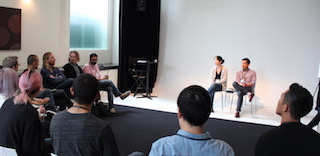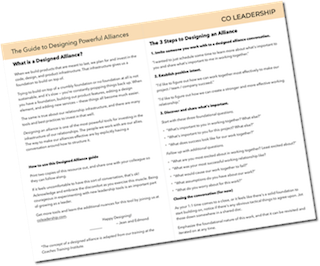Many years ago, I worked at a five-person startup.
I brought crackers and cheese and fruit that I had bought with my own groceries over the weekend and put them in the mini-fridge, so that we'd have snacks.
As we started to look for another Android engineer for our team, I put together an interview process and blogged about the process, so that we could attract even more candidates.
I drove to Berkeley to speak to college seniors about our product and handed out pamphlets. The night before, I had stayed up until midnight finishing the design for the pamphlets, and printed and cut 100 copies at the FedEx Office down the street.
I wore many different hats. Looking back, I realized that leaders fill any gaps that they notice across the company, and that this was my first foray into leadership.
But then I took a step backwards.
What got me here wouldn't get me there
When I joined Obvious (later called Medium) a year later, everyone seemed to know what they were doing. Everything ran smoothly — seaweed and an assortment of healthy snacks appeared as if by magic.
I had taken a step back in experience and seniority, but that was what I wanted — to work with and learn from more seasoned industry leaders. And so even though I saw gaps in what could be improved in recruiting, product, and engineering, I figured everyone else knew what they were doing. I kept my head down, offering up my opinion when it was asked, but not proactively offering it.
For awhile, this was fine. I focused on deepening my technical knowledge, ramped up in JavaScript, led a few product feature launches (because we didn't have PMs yet), and everything was fine. You're doing great, I heard — just keep doing what you're doing!
But when I came back from my first maternity leave, I was working 3 days a week, and had a constant stream of coding tasks.
I thought, I'll just focus on being super reliable in staying on top of those tasks. But a few months in, when I looked around, I realized the only thing that would happen if I always completed my tasks reliably, is that I would get more of them. No one was saying “Hey Jean, you're really good at doing all the things that have been assigned to you, so why don't you start leading this team of people?”
I kept waiting for someone to recognize the great work I was doing and to illuminate the path forward. After all, that's what had mostly worked for me in school, college, and the first few years of my professional career. It never happened.
I wasn't just standing idly by, waiting for authority to be bestowed upon me. I was finding scarce hours to write up and advocate for product changes I thought should happen. But the ideas would be dismissed because I didn't have enough higher-level company context.
Walking past important meetings in conference rooms with floor-to-ceiling glass walls was a constant reminder of my inadequacies.
One day I broke down crying in a session with a coach at Medium: “What's wrong with me, that everyone who joined before me or a year after me is running teams and leading projects, and I'm not?”
Leaders Notice and Fill in Gaps
The turning point for me was when I started working with my most recent manager, Dan. I had had an unpleasant code-review interaction (haven't we all!) with him at a previous company.
And I had created a very elaborate story in my head: every time he saw my face or my work, he was reminded of some sloppy code I had tried to merge into his team's codebase. In my story, he thought I was a terrible engineer, and was disappointed that the company had hired me (he was hired afterwards, so he didn't have a say in the matter).
Soon after I started reporting to him, we began meeting one-on-one, and I started to see that the story I had constructed was just that — a story. During a feedback session, he was visibly annoyed that my peers perceived me to be a mid-level engineer, and he was adamant that the work I was doing was squarely senior-level. I remember him saying to me, as we set goals for the next six months, “I think you'll be leading a team of 10 engineers.”
I was taken aback. I wasn't managing anyone at the time, and I didn't even imagine that possibility. In just a few minutes, he had noticed a very real gap in my personal aspirations and filled it with what he saw was possible for me.
In the months that followed, I lived up to those aspirations and got myself unstuck. I ended up leading a team of 15 engineers.
As a leader, Dan noticed my gap: the gap between my self-perception of my abilities and what was possible for me. He started filling it with that one powerful conversation, and continued to fill it in the months that followed, setting me up to in turn notice and fill in gaps that actually mattered to the team and the company. I shifted my energy to on-boarding engineers, training new technical interviewers, leading product teams, leading infrastructure projects that were critical for the company, and more.
Gaps Are Everywhere (Especially on Changing Teams)
Last month, I returned to Medium to run a three-workshop series with Edmond for some of the engineering leaders there. One of the workshops focused on the idea that “Leaders notice and fill in gaps.” We led the group through an exercise of noticing the gaps they saw in the company, and as people offered up gaps tentatively — communication gaps, process gaps, product gaps, perception gaps, alignment gaps — others vigorously nodded their heads throughout the room.
Get early access to future leadership workshops
Learn the most valuable frameworks and tools for effective leadership that we've picked up from coaching 100+ tech leads, managers, directors, engineering VPs, and CTOs.
Both in-person and online workshop experiences available.
After we added those gaps to the shared awareness of the group simply by noticing them openly, we split everyone up into smaller working groups to come up with next steps towards filling a few important gaps. The cohort of leaders left the workshop feeling empowered to take initiative within the company. “The group is well prepared to address and help fix the company’s hardest cultural barriers after the workshop!” one of the tech leads shared afterwards.
In our coaching and leadership development work, Edmond and I have seen the same patterns across all companies. As companies change rapidly, explicitness in role definition often lags behind growth and re-orgs, creating gaps in the organization — in communication about roles, in process, and in executive communication.
People don't step into these gaps for all sorts of reasons: it may be out of fear of stepping on other peoples' toes, or because they think they're the only one who is having trouble, or because they assume someone else will figure it out.
But what we've also seen is that leaders who emerge from these periods of uncertainty and change are those who don't sit back waiting for things to settle down or for someone else to figure things out. The leaders who emerge are those who take initiative and responsibility in noticing and filling the gaps.
So ask yourself:
What is the biggest painpoint when developing in the codebase?
What meetings are not efficiently run?
What do you wish you knew more about from the company's executives?
What is the gap between how someone on the team is perceived, and how they perceive themselves?
Then ask yourself, what do you want to do about it?
Get effective leadership frameworks & tools in your inbox
Learn the most valuable frameworks and tools for effective leadership that we've picked up from coaching 100+ tech leads, managers, directors, engineering VPs, and CTOs.





